A New Wood Adhesive Based on Recycling Camellia oleifera Cake-Protein: Preparation and Properties
Abstract
:1. Introduction
2. Materials and Methods
2.1. Materials
2.2. Preparation of Camellia oleifera Cake-Protein Hydrolysates
2.3. Preparation of Camellia oleifera Cake-Protein Adhesives
2.4. Preparation of Plywood and the Test of Bonding Strength
2.5. Insoluble Rate of Cured Adhesives
2.6. Fourier Transform-Infrared Spectroscopic (FT-IR) Analysis
2.7. Differential Scanning Calorimetric (DSC) Analysis
2.8. Thermogravimetric (TG) Analysis
2.9. X-ray Diffraction (XRD) Analysis
2.10. Scanning Electron Microscopic (SEM) Analysis
3. Results and Discussion
3.1. FT-IR Analysis of Camellia oleifera Cake-Protein Hydrolysates
3.2. Curing Performance of Camellia oleifera Cake-Protein Adhesives
- (1)
- The crosslinking reaction temperature between pure Camellia oleifera cake-protein hydrolysate and crosslinker was the highest, with the lowest heat release, indicating the low reactivity of pure Camellia oleifera cake-protein hydrolysate, its unideal reaction with the crosslinker, and a low crosslinking reaction degree.
- (2)
- The crosslinking reaction between Camellia oleifera cake-protein compound hydrolysate and crosslinker moved towards a low temperature, and the heat release was significantly increased, showing that the reactivity of the hydrolysate was significantly enhanced by introducing other proteins, which facilitated sufficient reaction with the crosslinker and reached a high degree of crosslinking reaction.
- (3)
- DSP-, SPI-, and casein-modified Camellia oleifera cake-protein adhesives all showed significant crosslinking reaction-induced exothermic peaks, but their peak temperature and heat release were different. The peak curing temperature of SPI-modified Camellia oleifera cake-protein adhesive (101.0 °C) < that of casein-modified Camellia oleifera cake-protein adhesive (105.8 °C) < that of DSP-modified Camellia oleifera cake-protein adhesive (106.2 °C).
3.3. SEM Analysis
3.4. Heat Resistance of Camellia oleifera Cake-Protein Adhesives
3.5. XRD Analysis
3.6. Insolubility Rate in the Cured Camellia oleifera Cake-Protein Adhesives
3.7. Basic Properties of Camellia oleifera Cake-Protein Adhesives
3.8. Reinforcement Mechanism Analysis of Camellia oleifera Cake-Protein Adhesives
4. Conclusions
- (1)
- DSP, SPI, and casein likely promoted the effective degradation of Camellia oleifera cake-protein; more active groups and reactivity sites were formed in the system; the initial viscosity and stability of the adhesive were reinforced, but its usable life was shortened.
- (2)
- DSP-, SPI-, and casein-modified Camellia oleifera cake-protein adhesives showed a lower curing reaction temperature and significantly increased heat release. SPI was more inclined to facilitate the degradation of Camellia oleifera cake-protein, so more active functional groups were exposed, and the active sites for the reaction with the crosslinker were increased, which contributed to the establishment of a compact crosslinked structure.
- (3)
- DSP, SPI, and casein, themselves, could be degraded into peptide chains with lower molecular weights, which improved the overall flexibility of the adhesive, boosted the elastic contact and regular array between the crosslinking products, and further enhanced the crosslinked structure and crosslinking density. The cured adhesive layer formed a compact reticular structure, with both bonding strength and water resistance being notably improved.
- (4)
- Based on the bonding performance, storage time and initial viscosity, the next step will be to adopt for study the DSP-modified Camellia oleifera cake-protein adhesive, mainly studying the amount of DSP, the amount of crosslinker, and the hot pressing process. Moreover, the results can also provide a reference for the development of other oil cake-protein adhesives.
Author Contributions
Funding
Institutional Review Board Statement
Informed Consent Statement
Data Availability Statement
Conflicts of Interest
References
- Zhao, S.; Wang, Z.; Li, Z.; Li, L.; Li, J.; Zhang, S. Core-shell nanohybrid elastomer based on co-deposition strategy to improve performance of soy protein adhesive. ACS Appl. Mater. Inter. 2019, 11, 32414–32422. [Google Scholar] [CrossRef] [PubMed]
- Cheng, S.; Yin, H.; Chen, M.; Zhao, J.; Zhao, D.; Chen, N. Preparation of waste newspaper reinforced soy-based adhesive and its boiling water resistance performance. J. For. Eng. 2020, 5, 82–87. [Google Scholar] [CrossRef]
- Guigo, N.; Mija, A.; Vincent, L.; Sbirrazzuoli, N. Eco-friendly composite resins based on renewable biomass resources: Polyfurfuryl alcohol/lignin thermosets. Eur. Polym. J. 2010, 46, 1016–1023. [Google Scholar] [CrossRef]
- Liu, Z.; Kou, F.; Duan, Y.; Wang, W.; Peng, L.; Li, J.; Gao, Q. Preparation and investigation of distillers-dried grains with solubles-based wood adhesive. J. For. Eng. 2021, 6, 105–111. [Google Scholar] [CrossRef]
- Liang, J.; Li, Q.; Wu, Z.; Du, G.; Li, T.; Lei, H.; Li, L. Competitive polycondensation of model compound melamine-urea-formaldehyed (MUF) resin system by 13C NMR. J. Bioresour. Bioprod. 2020, 5, 60–66. [Google Scholar] [CrossRef]
- Li, X.; Li, J.; Li, J. Research progress of urea formaldehyde resin modified by inorganic additives. J. For. Eng. 2021, 6, 28–34. [Google Scholar] [CrossRef]
- Qu, P.; Huang, H.; Wu, G.; Sun, E.; Chang, Z. The effect of hydrolyzed soy protein isolate on the structure and biodegradability of urea–formaldehyde adhesives. J. Adhes. Sci. Technol. 2015, 29, 502–517. [Google Scholar] [CrossRef]
- Qu, P.; Huang, H.; Wu, G.; Sun, E.; Chang, Z. Hydrolyzed soy protein isolates modified urea-formaldehyde resins as adhesives and its biodegradability. J. Adhes. Sci. Technol. 2015, 29, 2381–2398. [Google Scholar] [CrossRef]
- Wu, Z.; Zhang, B.; Zhou, X.; Yu, L.; Liao, J.; Du, G. Influence of single/collective use of curing agents on the curing behavior and bond strength of soy protein-melamine-urea-formaldehyde (SMUF) resin for plywood assembly. Polymers 2019, 11, 1995. [Google Scholar] [CrossRef] [Green Version]
- Ghahri, S.; Pizzi, A. Improving soy-based adhesives for wood particleboard by tannins addition. Wood Sci. Technol. 2018, 52, 261–279. [Google Scholar] [CrossRef]
- Xia, Z.; Li, J.; Zhang, J.; Zhang, X.; Zheng, X.; Zhang, J. Processing and valorization of cellulose, lignin and lignocellulose using ionic liquids. J. Bioresour. Bioprod. 2020, 5, 79–95. [Google Scholar] [CrossRef]
- Ballerini, A.; Despres, A.; Pizzi, A. Non-toxic, zero emission tannin-glyoxal adhesives for wood panels. Holz als Roh-und Werkstoff 2005, 63, 477–478. [Google Scholar] [CrossRef]
- Yu, Y.; Li, Y.; Lou, Y.; Liu, Y.; Yu, H. Effect of lignin condensation on cellulose enzymatic hydrolysis during deep eutectic solvent fractionation of lignocellulose. J. For. Eng. 2021, 6, 101–108. [Google Scholar] [CrossRef]
- Zhang, N.; Li, Z.; Xiao, Y.; Pan, Z.; Jia, P.; Feng, G.; Bao, C.; Zhou, Y.; Hua, L. Lignin-based phenolic resin modified with whisker silicon and its application. J. Bioresour. Bioprod. 2020, 5, 67–77. [Google Scholar] [CrossRef]
- Wang, Z.; Li, Z.; Gu, Z.; Hong, Y.; Cheng, L. Preparation, characterization and properties of starch-based wood adhesive. Carbohyd. Polym. 2012, 88, 699–706. [Google Scholar] [CrossRef]
- Li, D.; Zhuang, B.; Wang, X.; Wu, Z.; Wei, W.; Aladejana, J.T.; Hou, X.; Yves, K.G.; Xie, Y.; Liu, J. Chitosan used as a specific coupling agent to modify starch in preparation of adhesive film. J. Clean. Prod. 2020, 277, 123210. [Google Scholar] [CrossRef]
- Yang, I.; Kuo, M.; Deland, J.M. Bond quality of soy-based phenolic adhesives in southern pine plywood. J. Am. Oil Chem. Soc. 2013, 83, 213–237. [Google Scholar] [CrossRef]
- Wu, Z.; Xi, X.; Lei, H.; Liang, J.; Liao, J.; Du, G. Study on soy-based adhesives enhanced by phenol formaldehyde cross-linker. Polymers 2019, 11, 365. [Google Scholar] [CrossRef] [Green Version]
- Sun, Z.; Ye, R.; Jian, J.; Song, N.; Liu, T.; Fu, Q.; Gao, Z. Effect of pH of PAE resin on the structure and properties of soybean adhesive. J. For. Eng. 2021, 6, 130–136. [Google Scholar] [CrossRef]
- Li, K.; Jin, S.; Jiang, S.; Li, X.; Li, J.; Shi, S.Q.; Li, J. Bioinspired mineral–organic strategy for fabricating a high-strength, antibacterial, flame-retardant soy protein bioplastic via internal boron–nitrogen coordination. Chem. Eng. J. 2021, 428, 132616. [Google Scholar] [CrossRef]
- Pizzi, A. Recent developments in eco-efficient bio-based adhesives for wood bonding: Opportunities and issues. J. Adhes. Sci. Technol. 2006, 20, 829–846. [Google Scholar] [CrossRef]
- Wu, Z.; Xi, X.; Pizzi, A.; Xia, Y.; Zhao, Q.; Lei, H.; Liang, J. Effects of Broussonetia papyrifera leaf cutting modes on bonding performance of its protein-based adhesives. Eur. J. Wood Prod. 2020, 78, 461–470. [Google Scholar] [CrossRef]
- Guo, M. Protein-based wood adhesives. China For. Prod. Ind. 2005, 32, 3–7. [Google Scholar]
- Wang, F.; Zhang, H.; Wang, H.; Du, G. Preparation and performance of cold-pressed walnut cake based wood adhesive. China Oils Fats 2019, 44, 112–115. [Google Scholar] [CrossRef]
- Wei, X. Research on the Preparation of Plant Protein Adhesive by Sesame Cake and Meal; Henan University of Technology: Zhengzhou, China, 2018. [Google Scholar]
- Chen, Y.; Shi, A.; Hu, H.; Liu, L.; Liu, H.; Wang, Q. Application of peanut protein-based adhesive in plywood hot pressing process. China Oils Fats 2019, 44, 115–119. [Google Scholar]
- Lestari, D.; Mulder, W.J.; Sanders, J.P.M. Jatropha seed protein functional properties for technical applications. Biochem. Eng. J. 2011, 53, 297–304. [Google Scholar] [CrossRef]
- Zhang, S.; Liu, X.; Zhang, J.; Li, J. A novel formaldehyde-free adhesive from Jatropha Curcas press-cake. Adv. Mater. Res. 2011, 236–238, 1549–1553. [Google Scholar] [CrossRef]
- Hamarneh, A.I.; Heeres, H.J.; Broekhuis, A.A.; Picchioni, F. Extraction of Jatropha curcas proteins and application in polyketone-based wood adhesives. Int. J. Adhes. Adhes. 2010, 30, 615–625. [Google Scholar] [CrossRef]
- Chi, G. The Research of Using Jatropha Seed to Product Biodiesel and Adhesive; Guangxi University: Nanning, China, 2011. [Google Scholar]
- Wang, X.; Wu, Z.; Lei, H.; Du, G. Analysis of the bonding performances and curing properties of three kinds of protein-based adhesives. Shanghai Chem. Ind. 2017, 42, 19–23. [Google Scholar]
- Chen, S.; Liang, J.; Zhang, B.; Wu, Z.; Lei, H.; Li, L.; Yang, S. Study on Camellia Oleifera protein based wood adhesive by epoxy resin and its crosslinking mechanism. J. Wuhan Univ. Technol. Mater. Sci. Ed. 2021, 36, 607–613. [Google Scholar] [CrossRef]
- Deng, X.; Zhang, B.; Chen, S.; Li, D.; Wu, Z.; Liang, J.; Yang, S. Effects of NaOH treatment on degradation of Camellia oleifera seed protein and its adhesive properties. China Oils Fats 2021, 46, 21–25. [Google Scholar] [CrossRef]
- Wang, L.; Li, L.; Zhang, X.; Eizo, T. Study on soybean protein heating denaturation by DSC. J. China Agric. Univ. 2001, 6, 93–96. [Google Scholar]
- Li, C.; Tang, Y.; Wang, Y.; Yuan, X.; Zhang, B.; Wu, Z.; Tian, H. A novel environmental-friendly adhesive based on recycling of Broussonetia papyrifera left forestry waste protein. Forests 2022, 13, 291. [Google Scholar] [CrossRef]
- Luo, J.; Zhang, J.; Gao, Q.; Mao, A.; Li, J. Toughening and enhancing melamine-urea-formaldehyde resin properties via in situ polymerization of dialdehyde starch and microphase separation. Polymers 2019, 11, 1167. [Google Scholar] [CrossRef] [PubMed] [Green Version]
- Oyeoka, H.C.; Ewulonu, C.M.; Nwuzor, I.C.; Obele, C.M.; Nwabanne, J.T. Packaging and degradability properties of polyvinyl alcohol/gelatin nanocomposite films filled water hyacinth cellulose nanocrystals. J. Bioresour. Bioprod. 2021, 6, 168–185. [Google Scholar] [CrossRef]
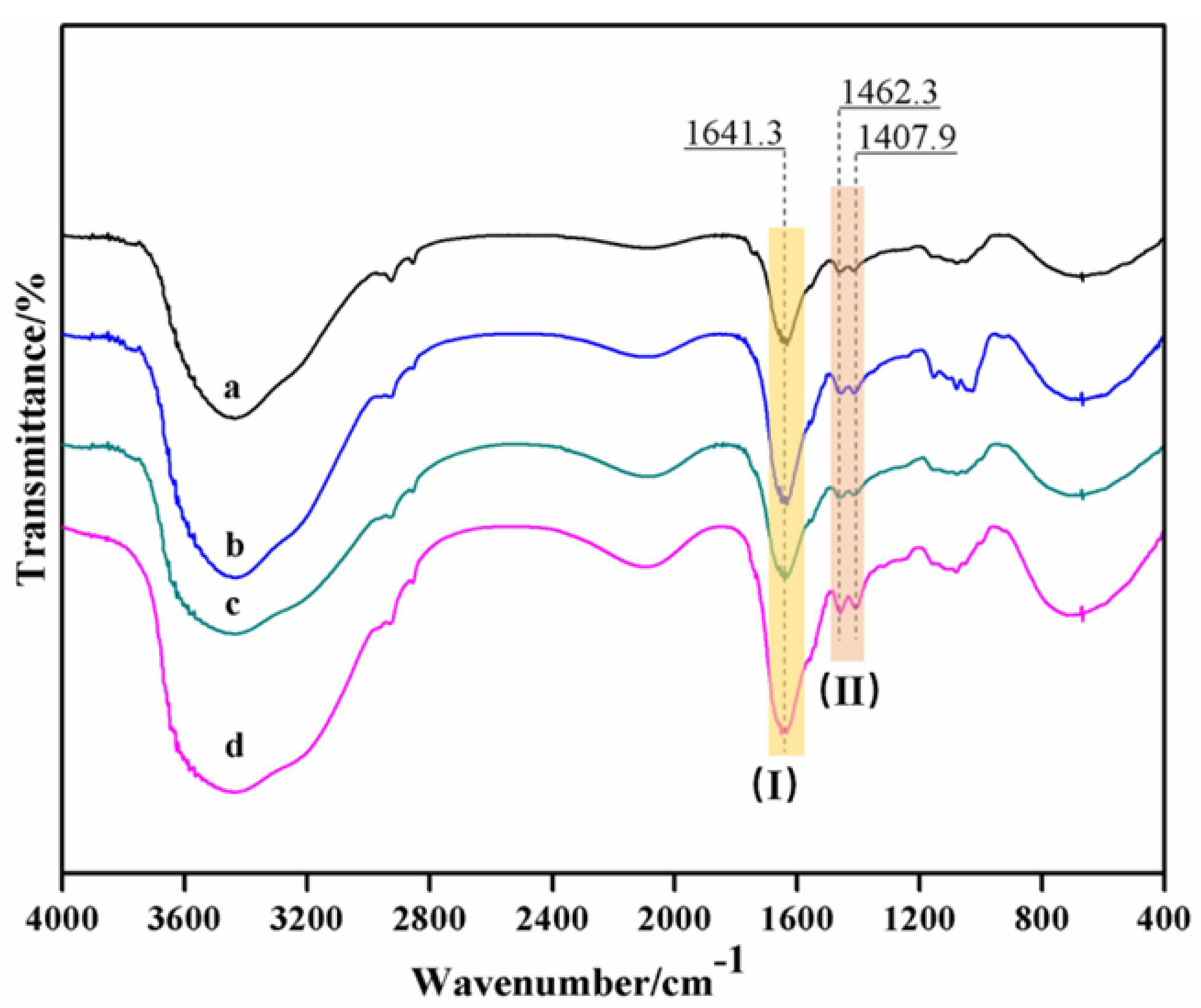
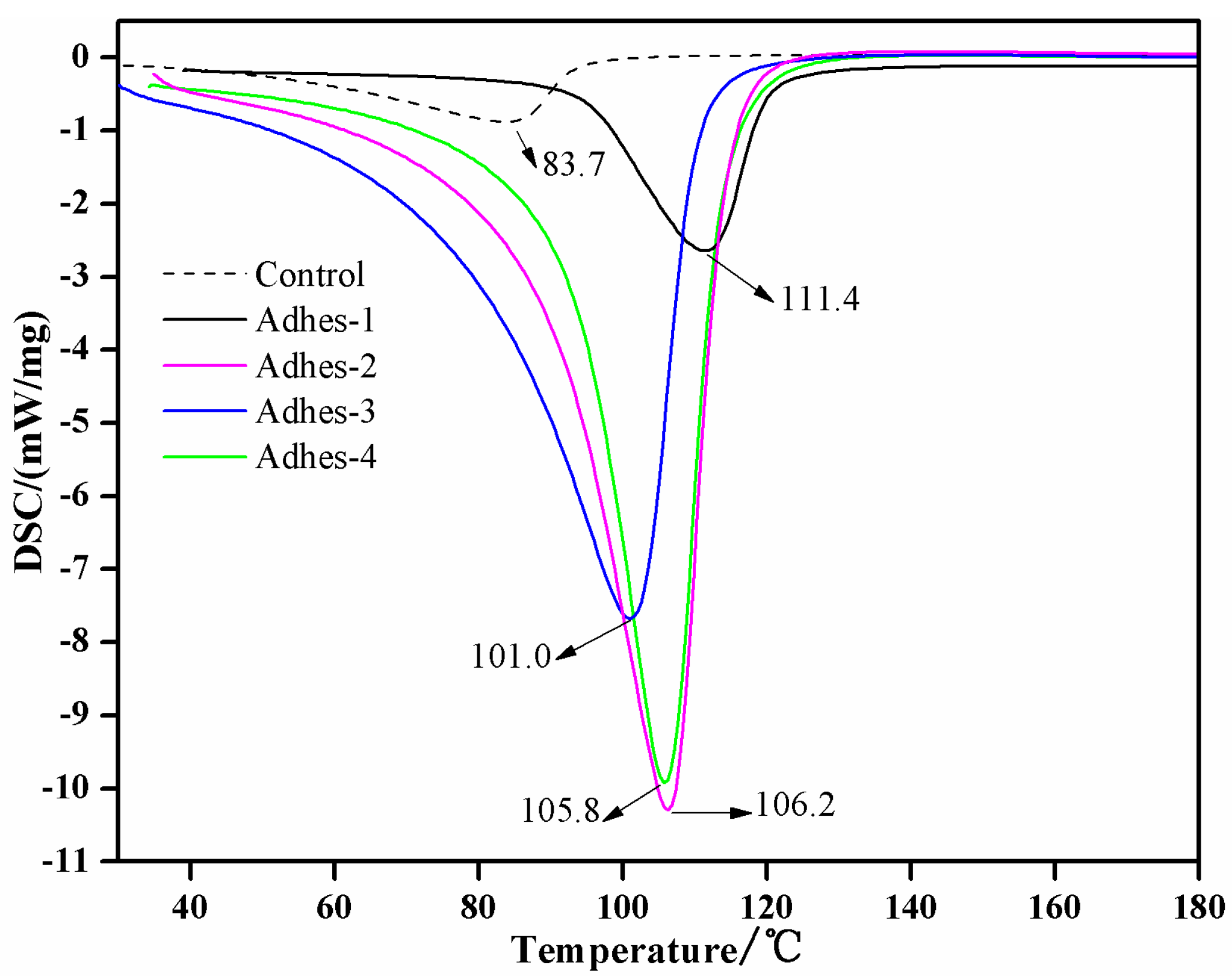
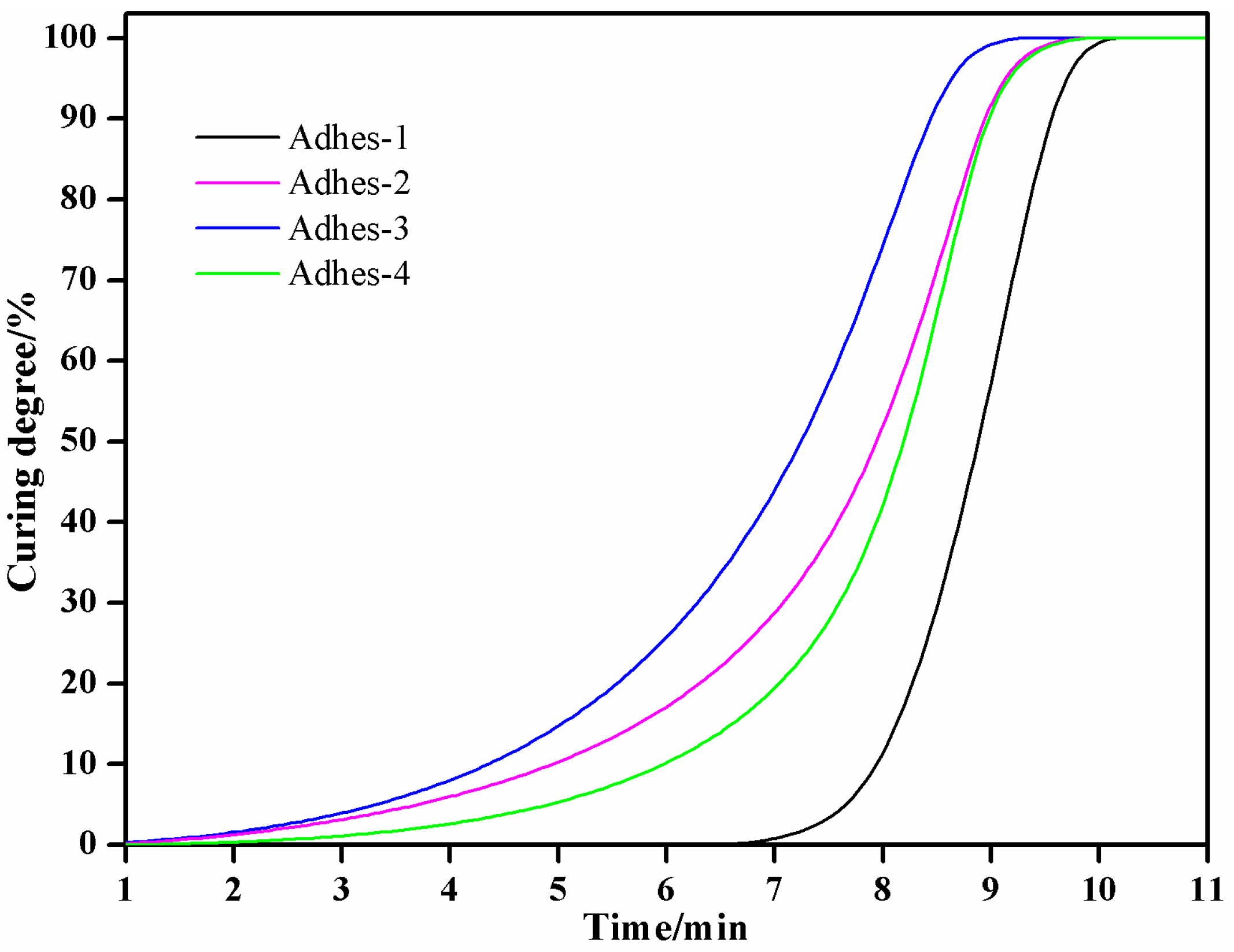


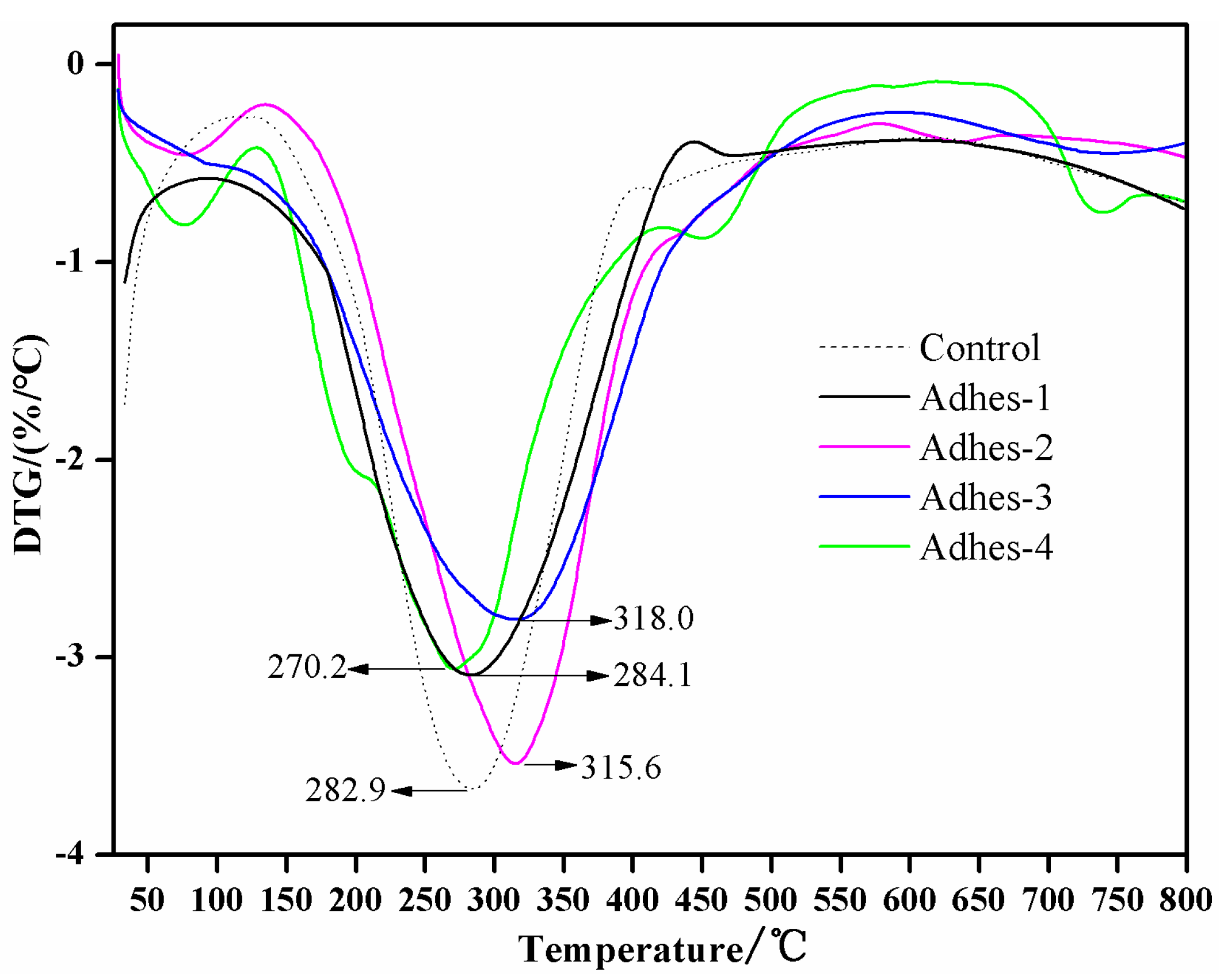
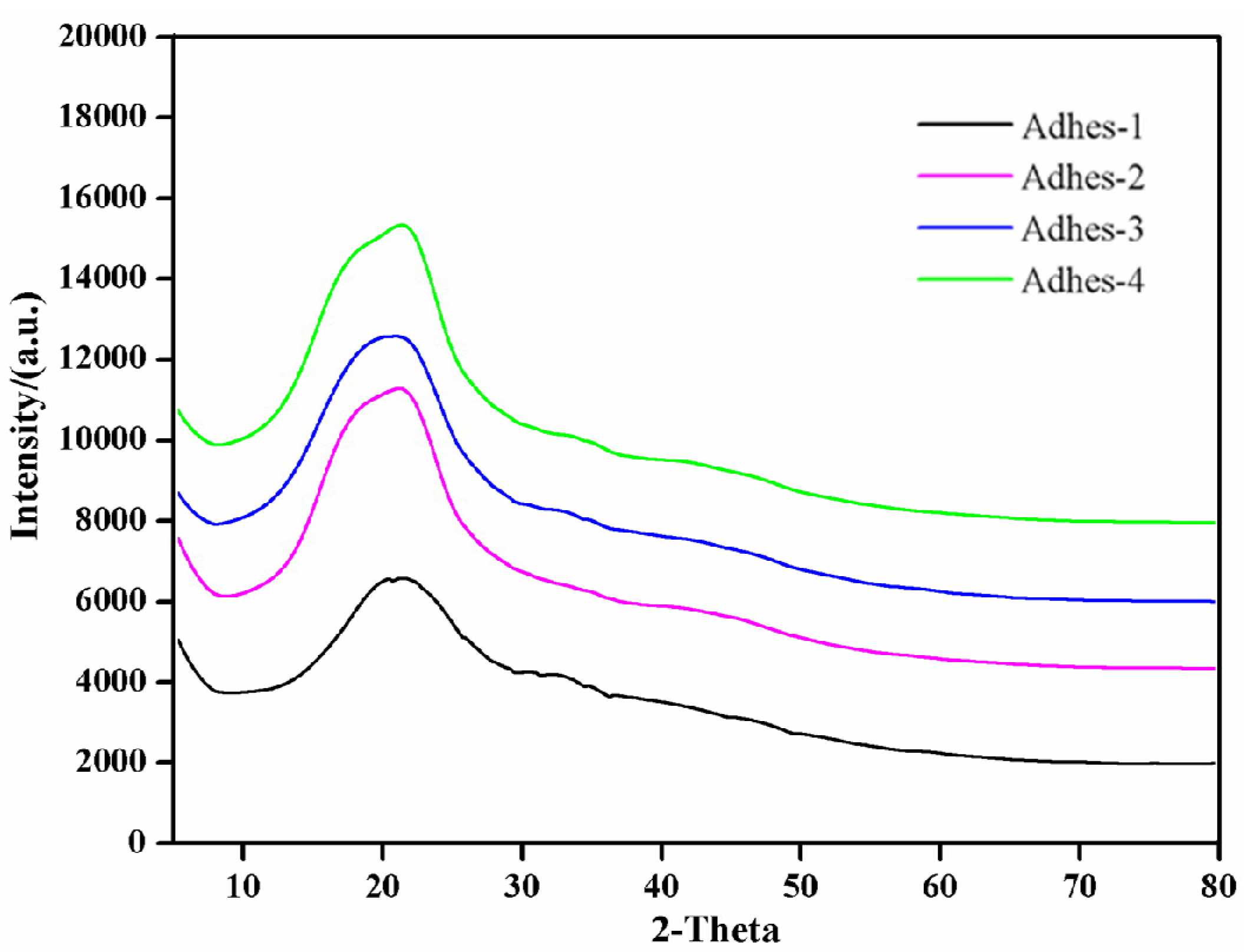
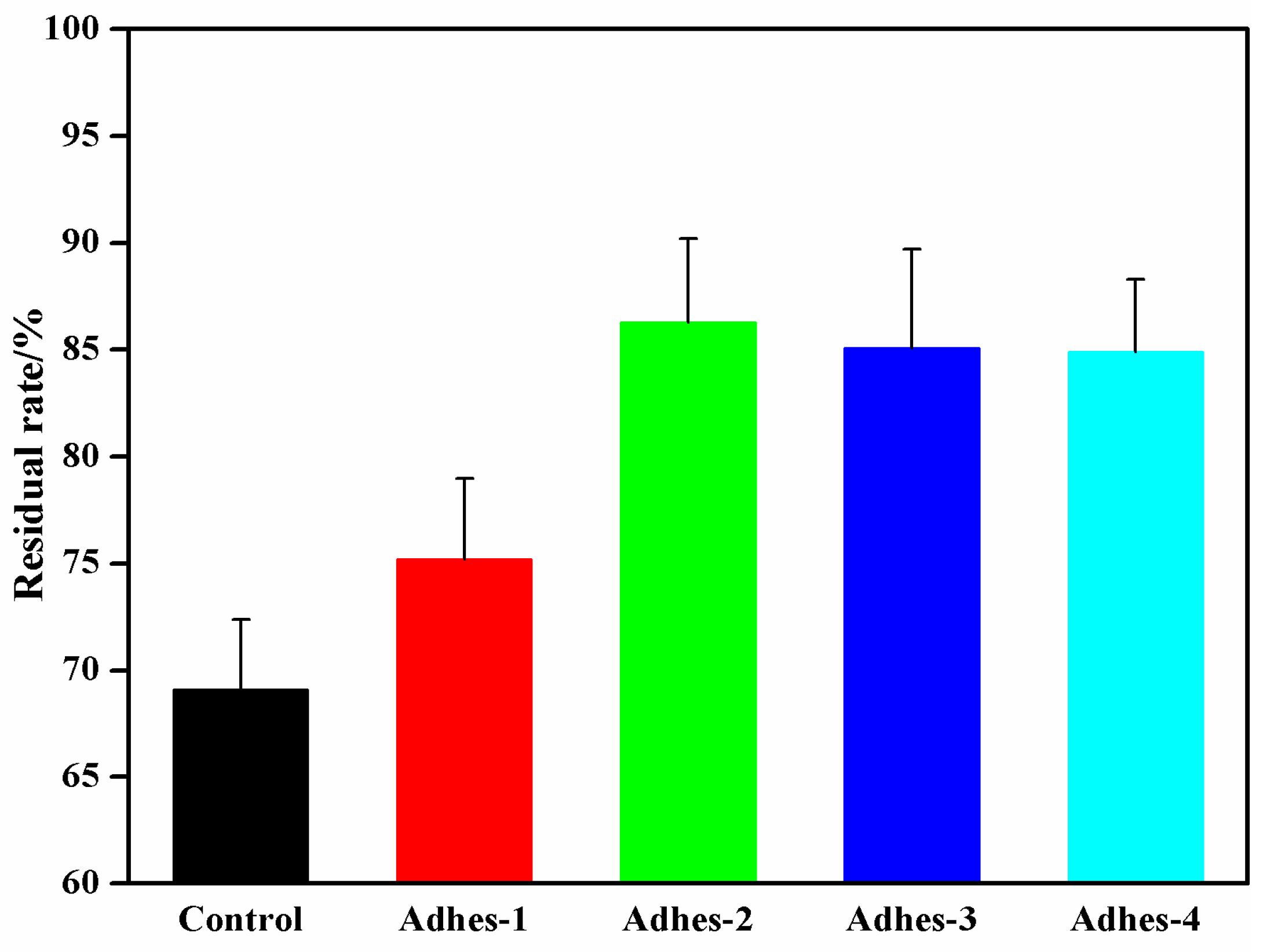
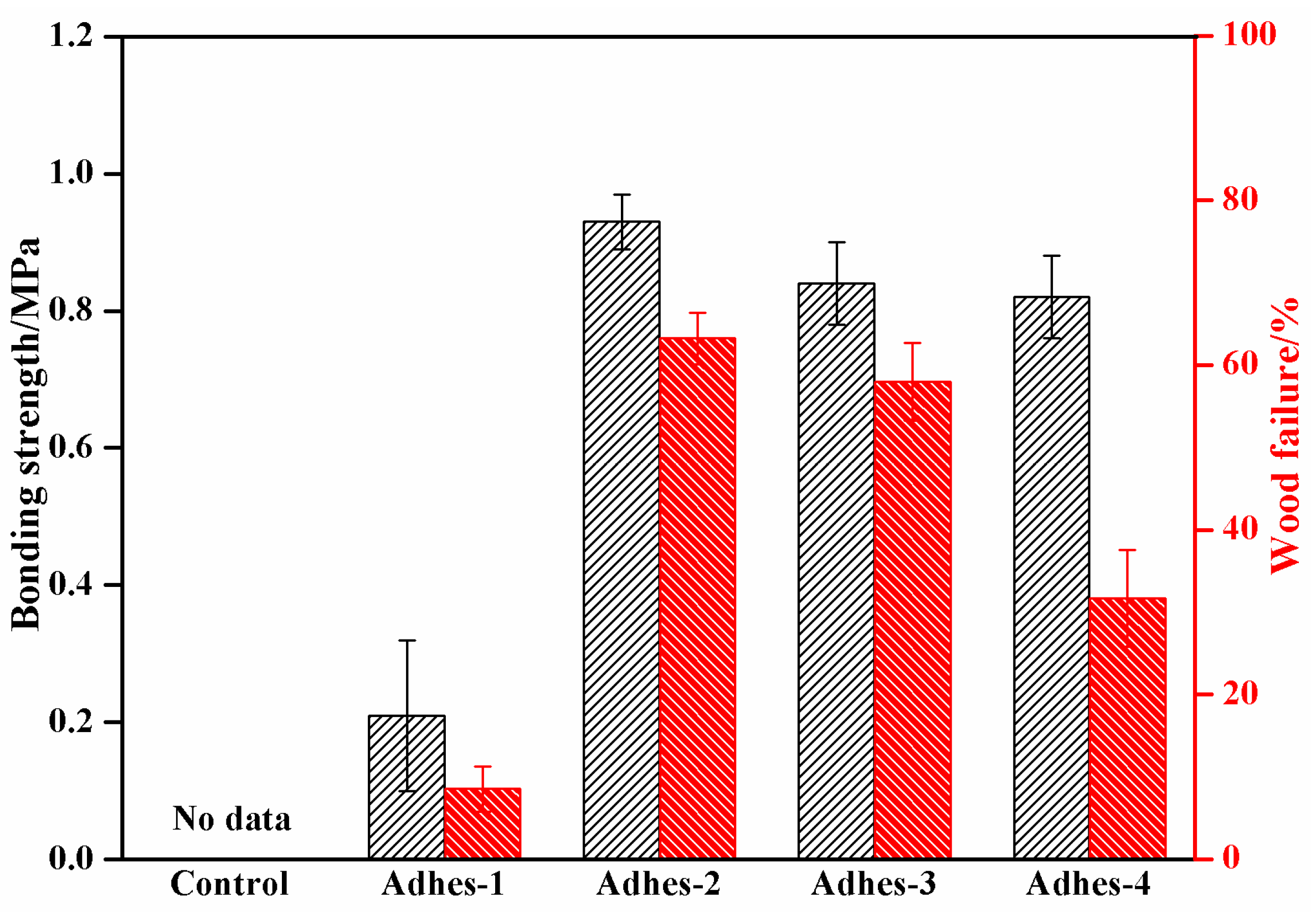
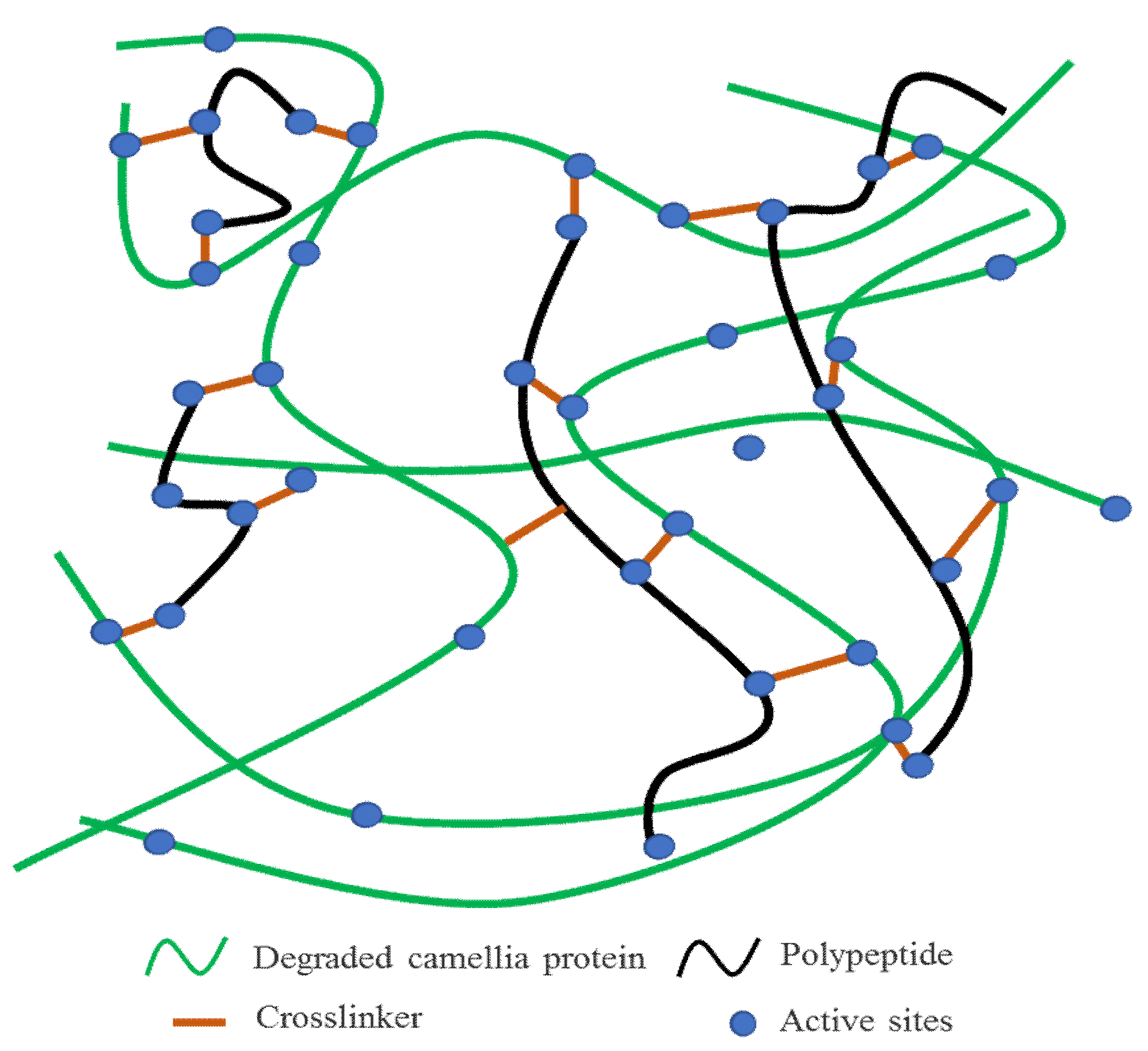
| Adhesives | Cake Protein/g | DSP /g | SPI /g | Casein /g | SDBS /g | Urea /g | NaOH /g | Crosslinker /% |
|---|---|---|---|---|---|---|---|---|
| Control | 80 | - | - | - | 1.2 | 8 | 4.8 | - |
| Adhes-1 | 80 | - | - | - | 1.2 | 8 | 4.8 | 12 |
| Adhes-2 | 72 | 8 | - | - | 1.2 | 8 | 4.8 | 12 |
| Adhes-3 | 72 | - | 8 | - | 1.2 | 8 | 4.8 | 12 |
| Adhes-4 | 72 | - | - | 8 | 1.2 | 8 | 4.8 | 12 |
| Adhesives | Viscosity/mPa·s | Storage Time/h | Remark |
|---|---|---|---|
| Control | 21.6 (±2.2) | 72 (±3.5) | Adhesive solution delaminated |
| Adhes-1 | 28.5 (±2.5) | 10 (±0.6) | Adhesive solution delaminated |
| Adhes-2 | 108.8 (±15) | 3 (±0.3) | Even adhesive solution |
| Adhes-3 | 115.0 (±13) | 2 (±0.3) | Even adhesive solution |
| Adhes-4 | 7698.3 (±364) | 1 (±0.2) | Even adhesive solution |
Publisher’s Note: MDPI stays neutral with regard to jurisdictional claims in published maps and institutional affiliations. |
© 2022 by the authors. Licensee MDPI, Basel, Switzerland. This article is an open access article distributed under the terms and conditions of the Creative Commons Attribution (CC BY) license (https://creativecommons.org/licenses/by/4.0/).
Share and Cite
Deng, X.; Wu, Z.; Zhang, B.; Lei, H.; Liang, J.; Li, L.; Tu, Y.; Li, D.; Xiao, G. A New Wood Adhesive Based on Recycling Camellia oleifera Cake-Protein: Preparation and Properties. Materials 2022, 15, 1659. https://doi.org/10.3390/ma15051659
Deng X, Wu Z, Zhang B, Lei H, Liang J, Li L, Tu Y, Li D, Xiao G. A New Wood Adhesive Based on Recycling Camellia oleifera Cake-Protein: Preparation and Properties. Materials. 2022; 15(5):1659. https://doi.org/10.3390/ma15051659
Chicago/Turabian StyleDeng, Xue, Zhigang Wu, Bengang Zhang, Hong Lei, Jiankun Liang, Lifen Li, Yuan Tu, De Li, and Guoming Xiao. 2022. "A New Wood Adhesive Based on Recycling Camellia oleifera Cake-Protein: Preparation and Properties" Materials 15, no. 5: 1659. https://doi.org/10.3390/ma15051659






